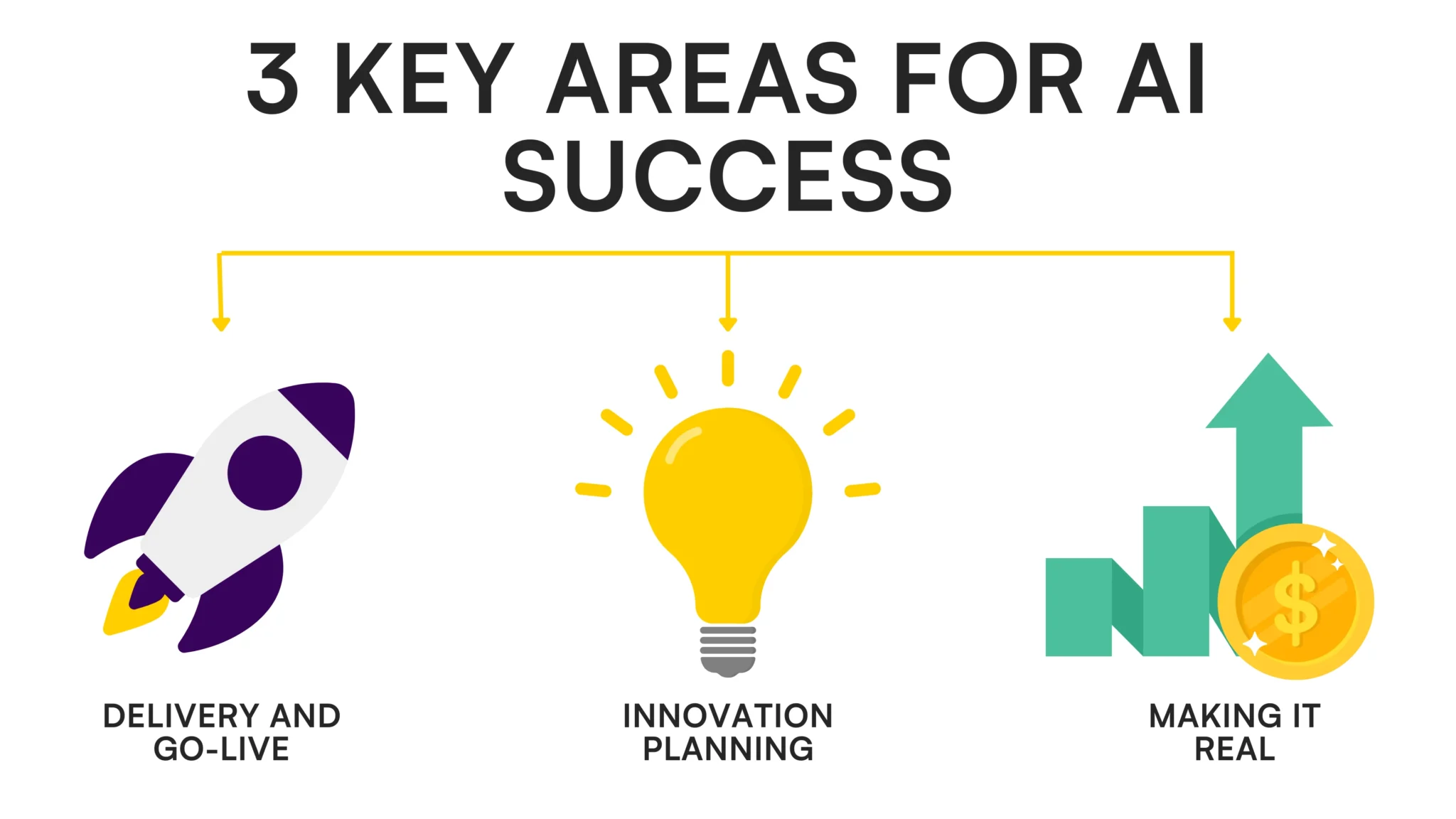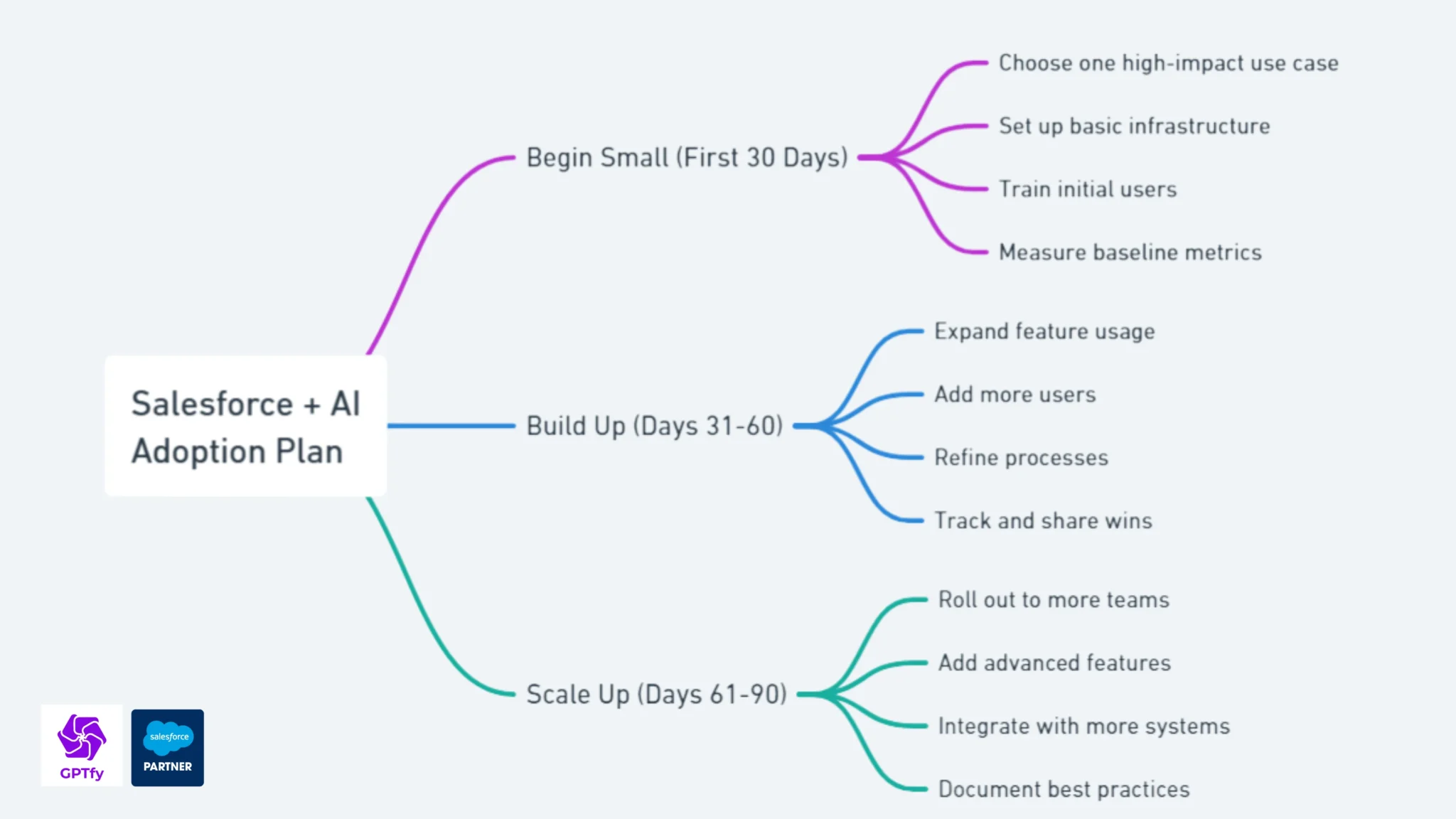Making It Work – Salesforce + AI From Pilot to Production
Table of Contents
- TL;DR
- Introduction
- 3 Key Areas for Salesforce + AI Success
- Bring Any AI Models to Your Salesforce
- Smart Start Plan for Salesforce + AI Implementation
- Conclusion
- Additional Resources
TL;DR
Moving from AI planning to production doesn’t have to be complex. Start with focused workshops, validate with quick POCs, and scale what works. Your journey from idea to implementation can begin in weeks, not months.
What?
A practical guide for moving from AI planning to real-world implementation in your Salesforce environment, focusing on delivery, innovation, and operational success.
Who?
This guide is for Salesforce teams, project managers, IT leaders, and business stakeholders ready to move their AI initiatives from planning to production.
Why?
To bridge the gap between AI strategy and real-world implementation while managing risks and delivering clear business value.
Move from ideas to action. Show real results. Scale success.
What can you do with it?
- Plan Your AI Journey: Structure your implementation from initial assessment through POC to full deployment with clear timelines and milestones.
- Drive Innovation: Build an AIOps framework that supports future growth, including multi-model AI implementations and cross-channel integration.
- Manage Implementation: Execute your AI rollout efficiently while addressing security, compliance, and user adoption challenges.
Introduction
The journey from AI planning to production is like building a bridge – you need solid foundations, careful engineering, and a clear path forward. While many organizations get stuck in endless planning cycles, successful teams know how to move from ideas to implementation systematically.
In my conversations with enterprise leaders, I’ve found that the difference between successful AI implementations and stalled projects often comes down to three key areas: delivery approach, innovation mindset, and operational excellence.
3 Key Areas for Salesforce + AI Success

Successful AI implementation relies on mastering three core areas: delivery approach, innovation mindset, and operational excellence. These proven pillars help organizations transform promising pilots into production success stories.
1. Delivery and Go-Live
A structured approach to implementation that balances speed with thoroughness, helping you validate assumptions quickly while building stakeholder confidence.
Assessment and Planning
Begin with clear objectives and strategic alignment:
- Run focused workshops with key stakeholders
- Document specific use cases and success criteria
- Build realistic timelines with clear milestones
- Align on priorities and resource needs
Quick Proof of Concept
Validate your approach in a controlled environment:
- Set up in a sandbox environment with sample data
- Test key features and integrations
- Measure performance and user experience
- Gather early feedback
Pilot and Initial Deploy
Scaling from controlled testing to real-world implementation:
- Choose a specific team or department
- Use real data and processes
- Track metrics and gather feedback
- Plan for a broader rollout
2. Innovation Planning
Future-proofing your AI implementation requires careful consideration of technical architecture and operational processes.
AIOps Considerations
Establishing robust operational frameworks for AI management:
- Plan your AI environment strategy
- Design migration and deployment processes
- Build testing and validation frameworks
- Create monitoring and maintenance plans
Future Possibilities
Preparing for emerging technologies and capabilities:
- Multi-model AI implementations
- External channel integration (mobile, web)
- Voice and telephony integration
- Partner ecosystem enablement
Change Management
Building sustainable adoption through user engagement:
- Track adoption metrics
- Identify power users and champions
- Document and share success stories
- Build training and support programs
3. Making It Real
Transforming vision into reality requires careful attention to practical considerations.
Funding and Budget
Creating a compelling business case for ongoing investment:
- Calculate clear ROI metrics
- Track both hard and soft benefits
- Plan for staged investments
- Monitor and report on value delivery
Internal Factors
Navigating organizational dynamics for successful implementation:
- Work with security and compliance teams early
- Build relationships with key stakeholders
- Create clear approval processes
- Keep communication channels open
Risk Management
Maintaining flexibility while protecting organizational interests:
- Monitor AI industry changes
- Build contingency plans
- Keep vendor options open
- Document lessons learned
Bring Any AI Models to Your Salesforce
Handle questions securely with AI. Works with Pro, Enterprise & Unlimited - your data never leaves Salesforce.
Smart Start Plan for Salesforce + AI Implementation

1. Begin Small (First 30 Days)
- Choose one high-impact use case
- Set up basic infrastructure
- Train initial users
- Measure baseline metrics
2. Build Up (Days 31–60)
- Expand feature usage
- Add more users
- Refine processes
- Track and share wins
3. Scale Up (Days 61–90)
- Roll out to more teams
- Add advanced features
- Integrate with more systems
- Document best practices
Conclusion
Remember, successful AI implementation isn’t about perfect planning – it’s about smart execution. Start small, learn fast, and scale what works. The key is to maintain momentum while managing risks and showing clear value along the way.